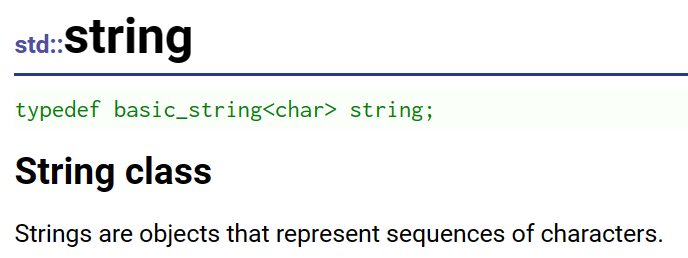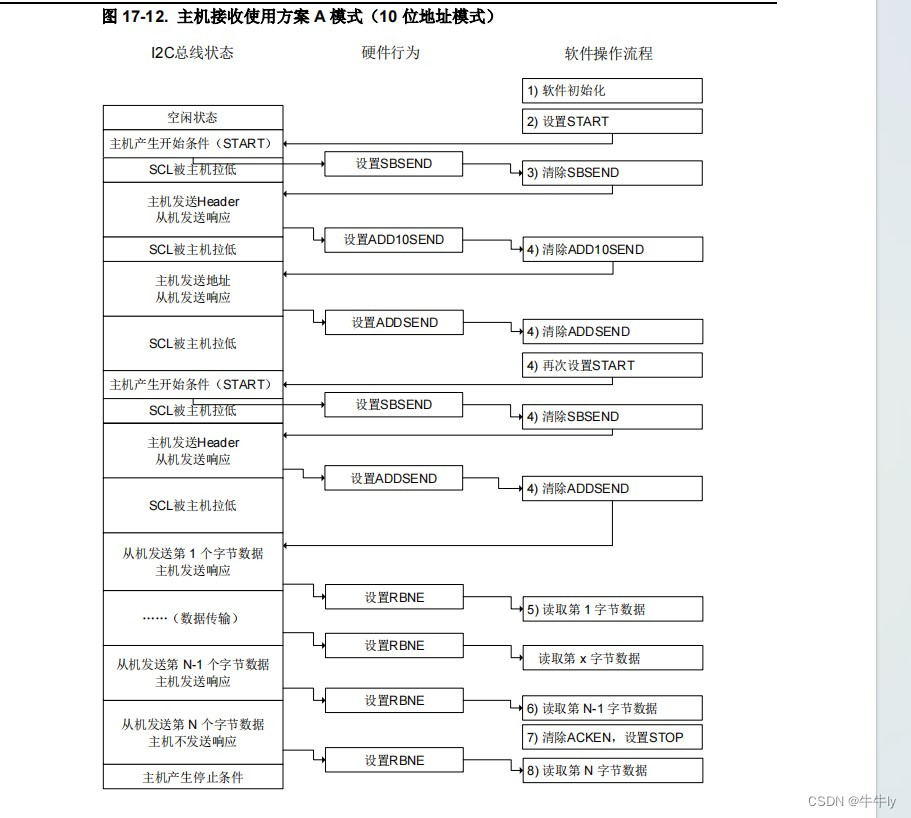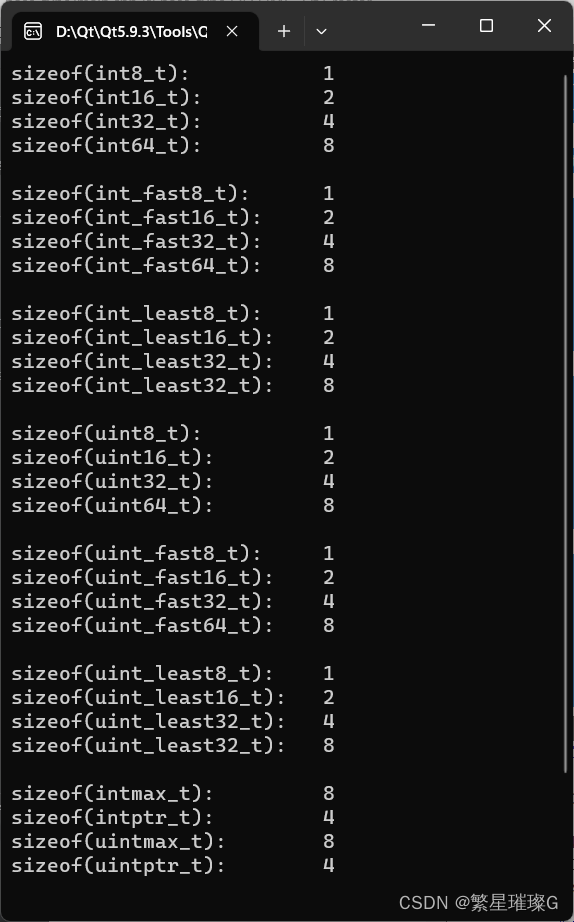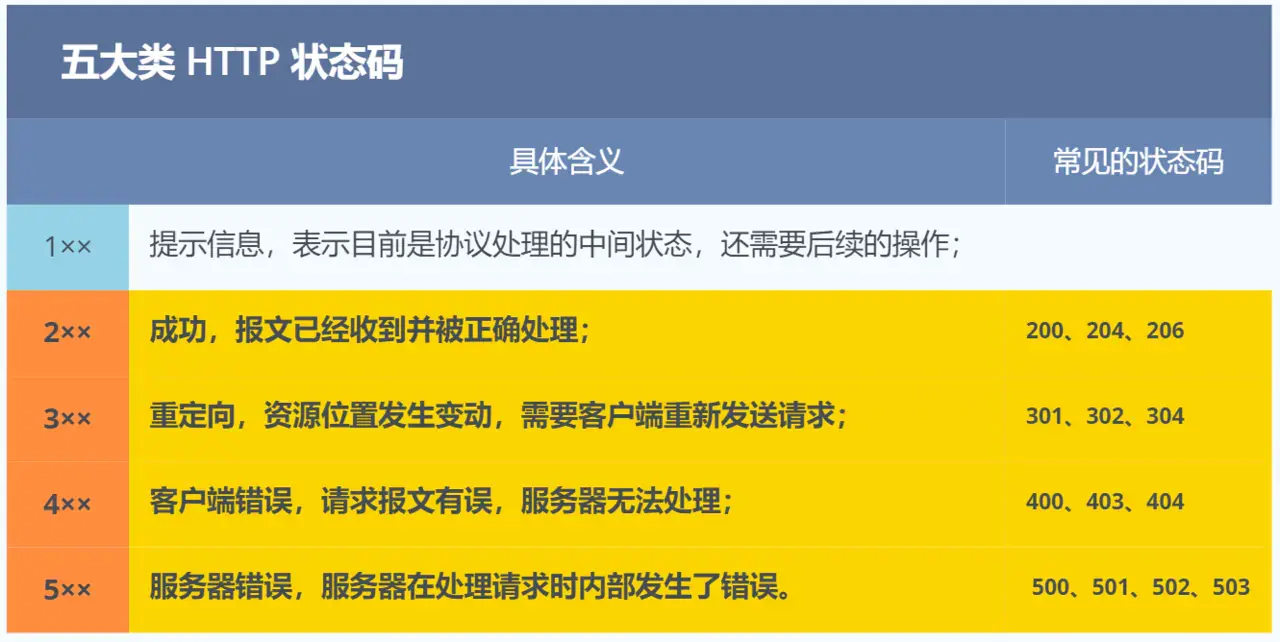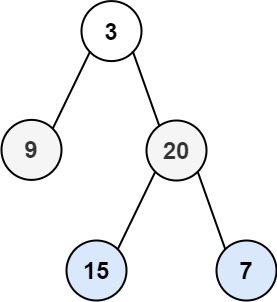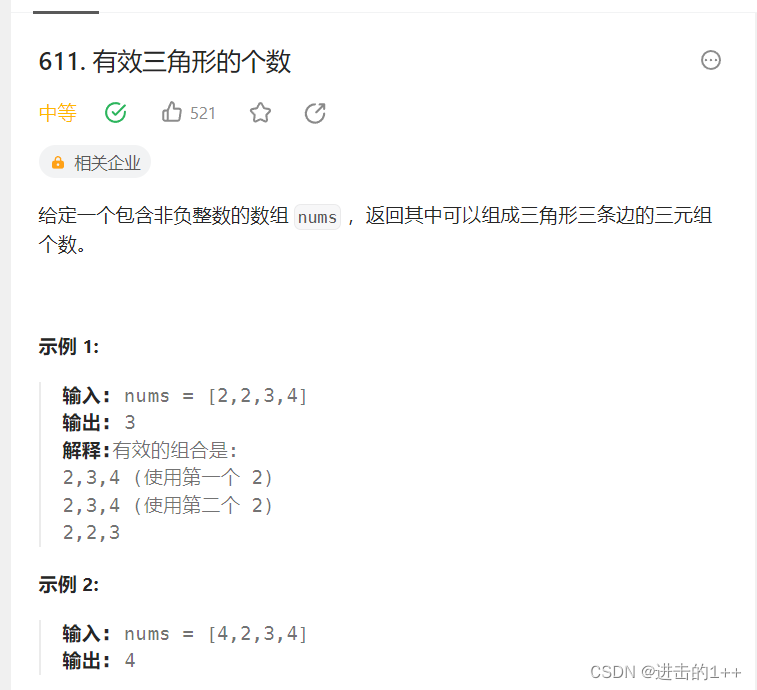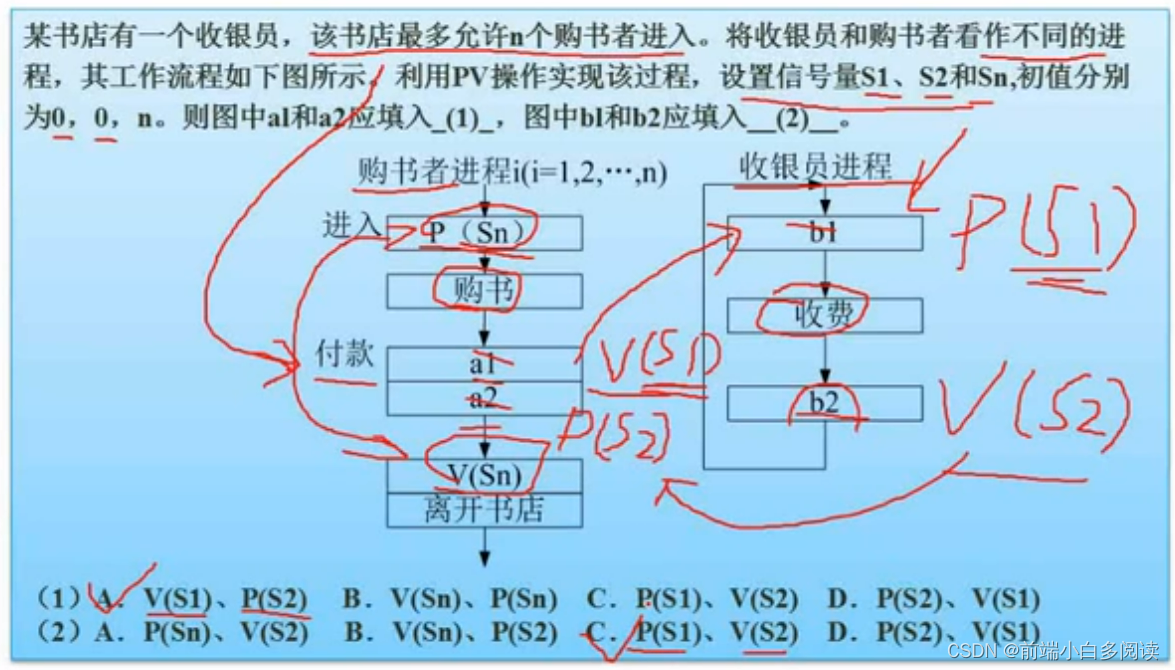⚪C语言中的字符串
C 语言中,字符串是以 '\0' 结尾的一些字符的集合,为了操作方便,C 标准库中提供了一些 str 系列的库函数,但是这些库函数与字符串是分离开的,不太符合 OOP 的思想,而且底层空间需要用户自己管理,稍不留神可能还会越界访问。
一、 标准库中的string类
1、string类(了解)
https://cplusplus.com/reference/string/string/?kw=string
- 字符串是表示字符序列的类。
- 标准的字符串类提供了对此类对象的支持,其接口类似于标准字符容器的接口,但添加了专门用于操作单字节字符字符串的设计特性。
- string 类是使用 char,即作为它的字符类型,使用它的默认 char_traits 和分配器类型(关于模板的更多信息,请参阅 basic_string )。
- string 类是 basic_string 模板类的一个实例,它使用 char 来实例化 basic_string 模板类,并用 char_traits 和 allocator 作为 basic_string 的默认参数(关于更多的模板信息请参考 basic_string )。
- 注意,这个类独立于所使用的编码来处理字节:如果用来处理多字节或变长字符(如: UTF-8 )的序列,这个类的所有成员(如长度或大小)以及它的迭代器,将仍然按照字节(而不是实际编码的字符)来操作。
【总结】
- string 是表示字符串的字符串类。
- 该类的接口与常规容器的接口基本相同,再添加了一些专门用来操作 string 的常规操作。
- string 在底层实际是:basic_string 模板类的别名,typedef basic_string<char, char_traits, allocator> string;
- 不能操作多字节或者变长字符的序列。
在使用 string 类 时,必须包含 #include 头文件 以及 using namespace std;
⚪补充(编码)
(1)ASCII
ASCII (American Standard Code for Information Interchange):美国信息交换标准代码是基于拉丁字母的一套电脑编码系统。ASCII 到目前为止共定义了 128 个字符。
在计算机中,所有的数据在存储和运算时都要使用二进制数表示。例如,像 a、b、c、d 这样的 52 个字母(包括大写)以及 0、1 等数字还有一些常用的符号(例如 *、#、@ 等)在计算机中存储时也要使用二进制数来表示,而具体用哪些二进制数字表示哪个符号,当然每个人都可以约定自己的一套(这就叫编码)。
ASCII 码使用指定的 7 位或 8 位二进制数组合来表示 128 或 256 种可能的字符。标准 ASCII 码也叫基础 ASCII 码,使用 7 位二进制数(剩下的 1 位二进制为 0)来表示所有的大写和小写字母,数字 0 到 9、标点符号,以及在美式英语中使用的特殊控制字符。
常见 ASCII 码的大小规则:数字< 大写字母 < 小写字母。
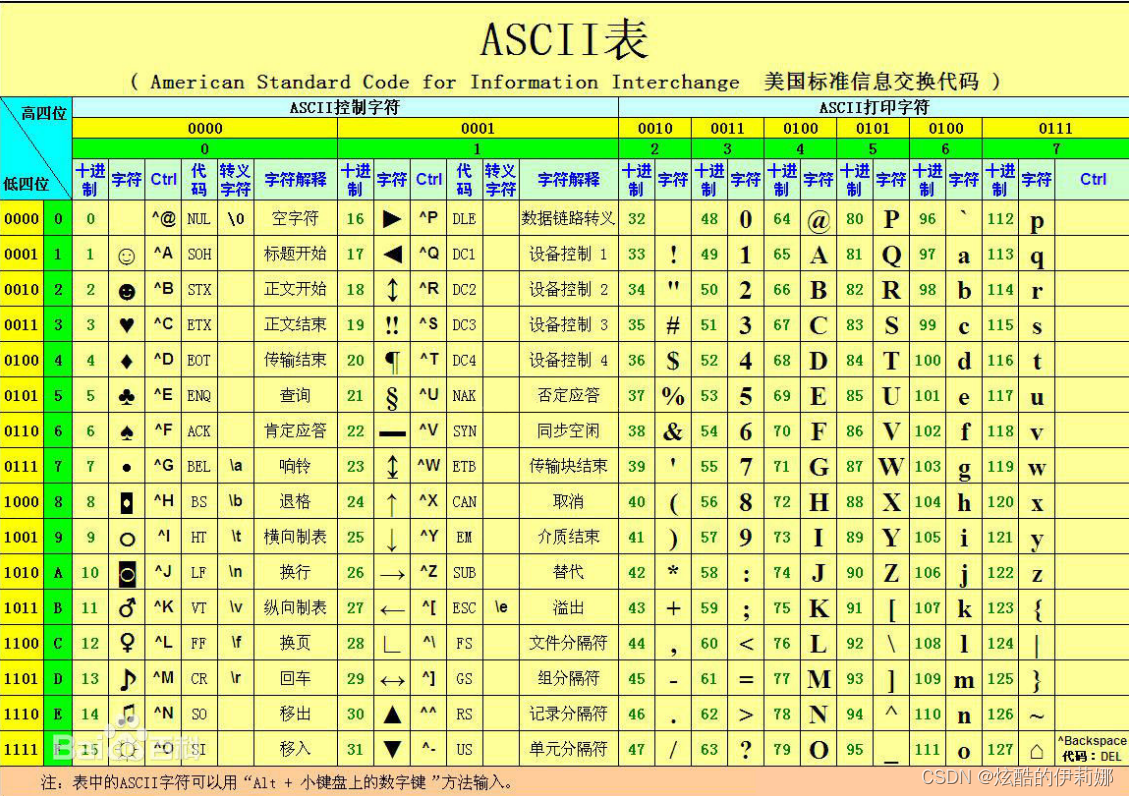
(2)UTF-8
UTF-8( 8 位元,Universal Character Set/Unicode Transformation Format)是针对 Unicode 的一种可变长度字符编码。它可以用来表示 Unicode 标准中的任何字符,而且其编码中的第一个字节仍与 ASCII 相容,使得原来处理 ASCII 字符的软件无须或只进行少部分修改后,便可继续使用。
Unicode 的编码方式有三种:UTF-8、UTF-16、UTF-32( UTF 后的数字代表编码的最小单位,如UTF-8 表示最小单位 1 字节)。由于 UTF-8 与字节序无关(无需 BOM ),同时兼容 ASCII 编码,使得 UTF-8 编码成为现今互联网信息编码标准而被广泛使用。

2、string类的常用接口说明(最常用的接口)
(1)string类对象的常见构造
https://cplusplus.com/reference/string/string/?kw=string

void Teststring()
{
string s1; // 构造空的string类对象s1
string s2("hello world"); // 用C格式字符串构造string类对象s2
string s3(s2); // 拷贝构造s3
}(2)string类对象的容量操作
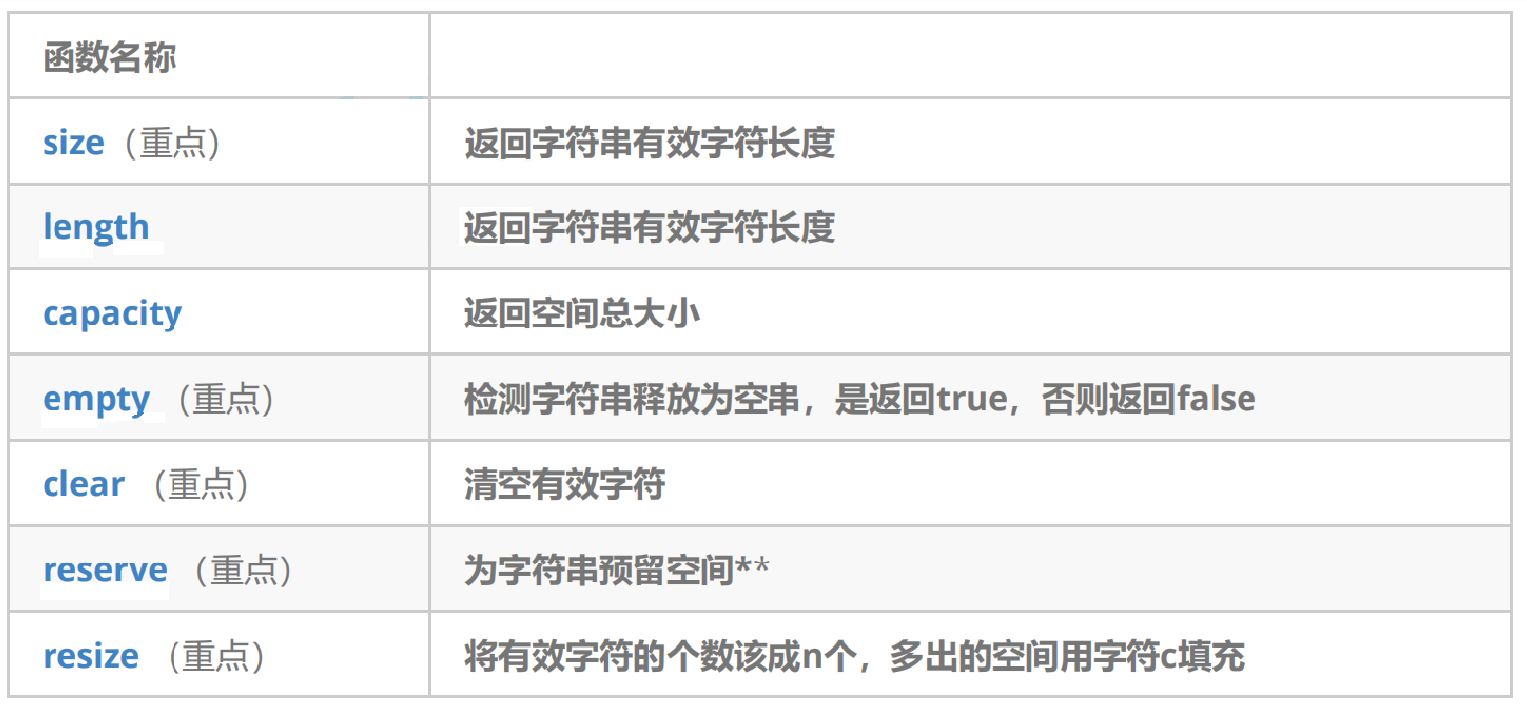
string 容量相关方法使用代码演示:
#include <iostream>
using namespace std;
#include <string>
// 测试string容量相关的接口:size/clear/resize
void Teststring1()
{
// 注意:string类对象支持直接用cin和cout进行输入和输出
string s("hello world!");
cout << s.size() << endl; //12
cout << s.length() << endl; //12
cout << s.capacity() << endl; //15
cout << s << endl; //hello world!
// 将s中的字符串清空,注意清空时只是将size清0,不改变底层空间的大小
s.clear();
cout << s.size() << endl; //0
cout << s.capacity() << endl; //15
// 将s中有效字符个数增加到10个,多出的位置用'a'进行填充
// “aaaaaaaaaa”
s.resize(10, 'a');
cout << s.size() << endl; //10
cout << s.capacity() << endl; //15
// 将s中有效字符个数增加到15个,多出位置用缺省值'\0'进行填充
// "aaaaaaaaaa\0\0\0\0\0"
// 注意此时s中有效字符个数已经增加到15个
s.resize(15);
cout << s.size() << endl; //15
cout << s.capacity() << endl; //15
cout << s << endl; //aaaaaaaaaa
// 将s中有效字符个数缩小到5个
s.resize(5);
cout << s.size() << endl; //5
cout << s.capacity() << endl; //15
cout << s << endl; //aaaaa
}void Teststring2()
{
string s;
s.reserve(100);
cout << s.size() << endl; //0
cout << s.capacity() << endl; //111
// reserve参数小于string的底层空间大小时,不会将空间缩小
s.reserve(50);
cout << s.size() << endl; //0
cout << s.capacity() << endl; //111
}利用 reserve 提高插入数据的效率,避免增容带来的开销。
void TestPushBack()
{
string s;
size_t sz = s.capacity();
cout << "making s grow:\n";
for (int i = 0; i < 100; ++i)
{
s.push_back('c');
if (sz != s.capacity())
{
sz = s.capacity();
cout << "capacity changed: " << sz << '\n';
}
}
}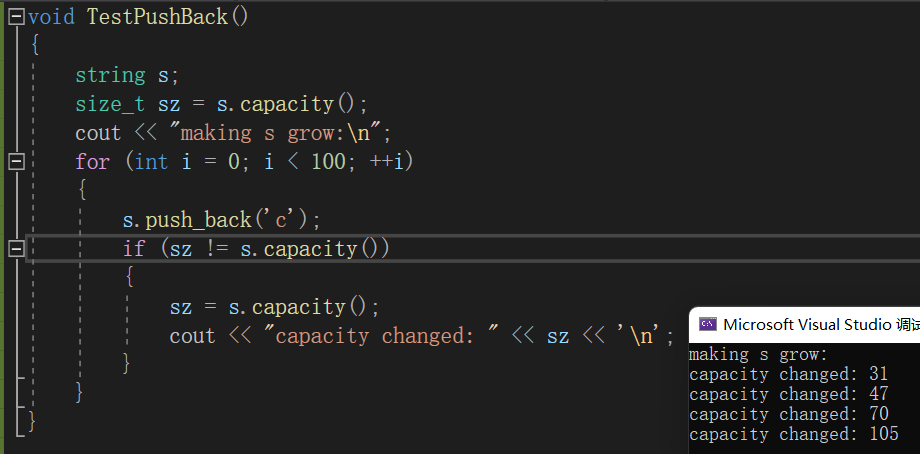
void TestPushBackReserve()
{
string s;
s.reserve(100);
size_t sz = s.capacity();
cout << "making s grow:\n";
for (int i = 0; i < 100; ++i)
{
s.push_back('c');
if (sz != s.capacity())
{
sz = s.capacity();
cout << "capacity changed: " << sz << '\n';
}
}
}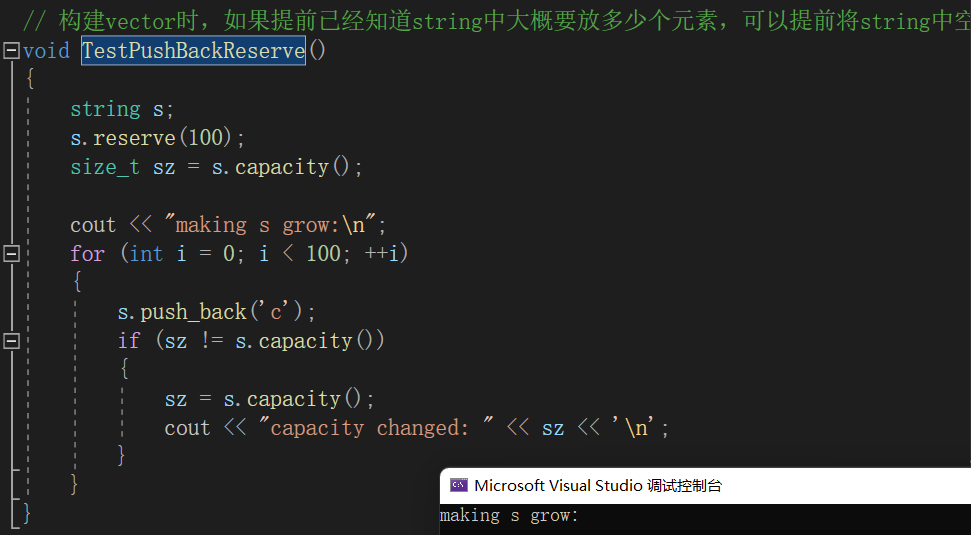
构建 vector 时,如果提前已经知道 string 中大概要放多少个元素,可以提前将 string 中空间设置好。
void Teststring3()
{
string s1("hello World");
const string s2("Hello World");
cout << s1 << " " << s2 << endl;
cout << s1[0] << " " << s2[0] << endl;
s1[0] = 'H';
cout << s1 << endl;
// s2[0] = 'h'; //编译失败,因为const类型对象不能修改
}注意:
- size() 与 length() 方法底层实现原理完全相同,引入 size() 的原因是为了与其他容器的接口保持一致,一般情况下基本都是用 size()。
- clear() 只是将 string 中有效字符清空,不改变底层空间大小。
- resize(size_t n) 与 resize(size_t n, char c) 都是将字符串中有效字符个数改变到 n 个,不同的是当字符个数增多时:resize(n) 用 0 来填充多出的元素空间,resize(size_t n, char c) 用字符 c 来填充多出的元素空间。注意:resize 在改变元素个数时,如果是将元素个数增多,可能会改变底层容量的大小,如果是将元素个数减少,底层空间总大小不变。
- reserve(size_t res_arg=0):为 string 预留空间,不改变有效元素个数,当 reserve 的参数小于 string 的底层空间总大小时,reserver 不会改变容量大小。
(3)string类对象的访问及遍历操作
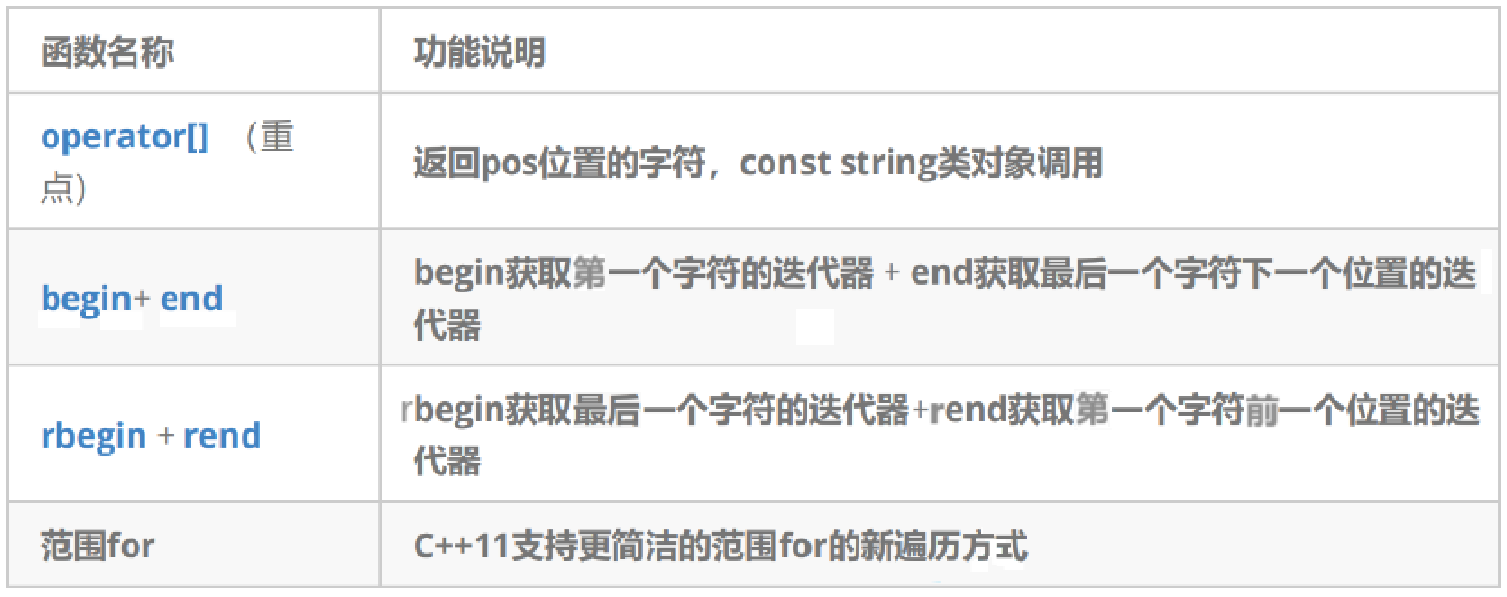
string 中元素访问及遍历代码演示:
string 的遍历:
- for+operator[]
- 迭代器
- 范围 for
注意:string 遍历时使用最多的还是 for+ 下标或者范围 for(C++11 后才支持)。
begin() + end() 大多数使用在需要使用 STL 提供的算法操作 string 时,比如:采用 reverse 逆置 string。需要注意的以上三种方式除了遍历 string 对象,还可以遍历是修改 string 中的字符。
另外这三种方式对于 string 而言,第一种使用最多。
void Teststring4()
{
string s("hello World");
// 1、for+operator[]
for (size_t i = 0; i < s.size(); ++i)
{
cout << s[i] << " ";
}
cout << endl;
// 2、迭代器
string::iterator it = s.begin();
while (it != s.end())
{
cout << *it << " ";
++it;
}
cout << endl;
// string::reverse_iterator rit = s.rbegin();
// C++11之后,直接使用auto定义迭代器,让编译器推到迭代器的类型
auto rit = s.rbegin(); // 创建一个反向迭代器rit,指向字符串s的最后一个字符
while (rit != s.rend()) // 当反向迭代器不等于s的逆向结束迭代器时
{
cout << *rit << " ";
++rit; // 将迭代器向前移动一位
}
cout << endl;
// 3、范围for
for (auto ch : s)
{
cout << ch << " ";
}
cout << endl;
}
(4)string类对象的修改操作
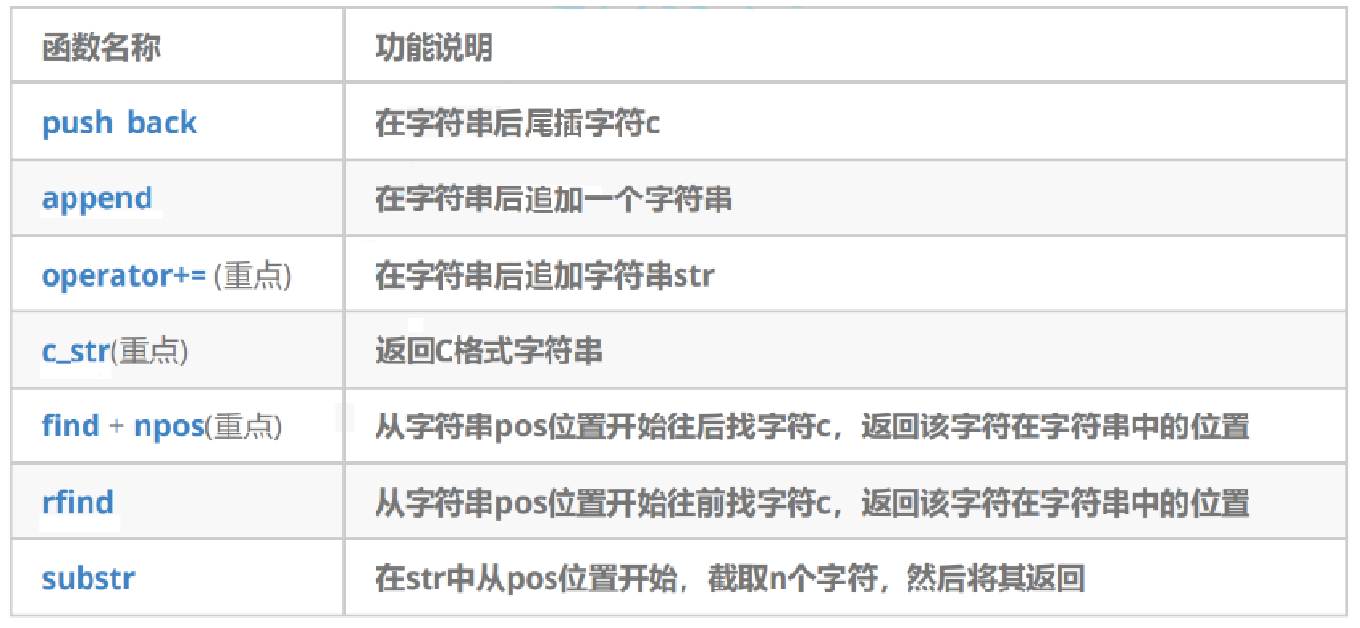
- 插入(拼接)方式:push_back append operator+=
- 正向和反向查找:find() + rfind()
- 截取子串:substr()
- 删除:erase
void Teststring5()
{
string str;
str.push_back(' '); // 在str后插入空格
str.append("hello"); // 在str后追加一个字符"hello"
str += 'w'; // 在str后追加一个字符'w'
str += "orld"; // 在str后追加一个字符串"orld"
cout << str << endl;
cout << str.c_str() << endl; // 以C语言的方式打印字符串
// 获取file的后缀
string file("string.cpp");
size_t pos = file.rfind('.');
string suffix(file.substr(pos, file.size() - pos));
cout << suffix << endl;
// 取出url中的域名
string url("http://www.cplusplus.com/reference/string/string/find/");
cout << url << endl;
size_t start = url.find("://");
if (start == string::npos)
{
cout << "invalid url" << endl;
return;
}
start += 3;
size_t finish = url.find('/', start);
string address = url.substr(start, finish - start);
cout << address << endl;
// 删除url的协议前缀
pos = url.find("://");
url.erase(0, pos + 3);
cout << url << endl;
}
npos 是 string 里面的一个静态成员变量。
注意 :
- 在 string 尾部追加字符时,s.push_back(c) / s.append(1, c) / s += 'c' 三种的实现方式差不多,一般情况下 string 类的 += 操作用的比较多,+= 操作不仅可以连接单个字符,还可以连接字符串。
- 对 string 操作时,如果能够大概预估到放多少字符,可以先通过 reserve 把空间预留好。
(5)string类非成员函数
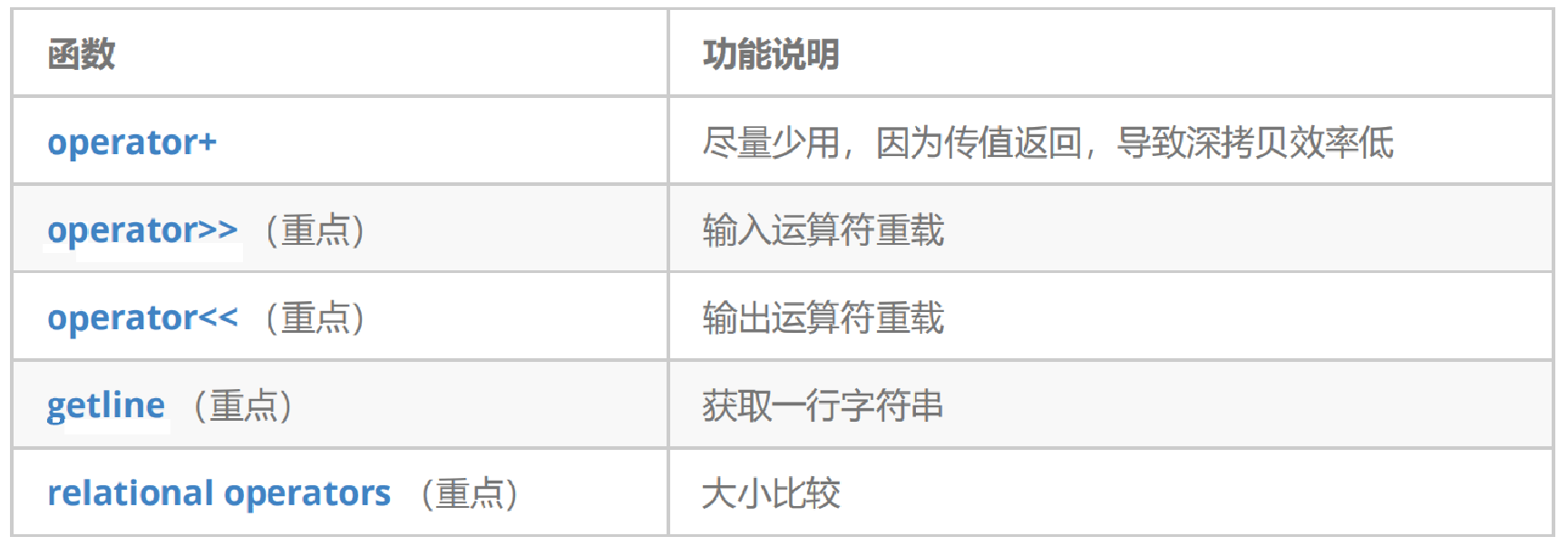
(6)VS和g++下string结构的说明
注意 :下述结构是在 32 位平台下进行验证,32 位平台下指针占 4 个字节。
⚪VS下string的结构
string 总共占 28 个字节,内部结构稍微复杂一点,先是有一个联合体,联合体用来定义 string 中字 符串的存储空间:
- 当字符串长度小于 16 时,使用内部固定的字符数组来存放。
- 当字符串长度大于等于 16 时,从堆上开辟空间。
union _Bxty
{ // storage for small buffer or pointer to larger one
value_type _Buf[_BUF_SIZE];
pointer _Ptr;
char _Alias[_BUF_SIZE]; // to permit aliasing
} _Bx;这个联合体的目的是为了在存储较小的数据时使用数组,而在存储较大的数据时使用指针。通过使用联合体,可以在相同的内存空间中灵活地存储不同类型的数据。
注意:联合体的成员变量共享同一块内存空间,因此在使用时需要确保对应的成员变量是有效的。
这种设计也是有一定道理的,大多数情况下字符串的长度都小于 16,那 string 对象创建好之后,内部已经有了 16 个字符数组的固定空间,不需要通过堆创建,效率高。其次,还有一个 size_t 字段保存字符串长度,占用4个字节, 一个 size_t 字段保存从堆上开辟空间总的容量,占用4个字节 。最后,还有一个指针做一些其他事情,占用4个字节 。故总共占 16+4+4+4=28 个字节。
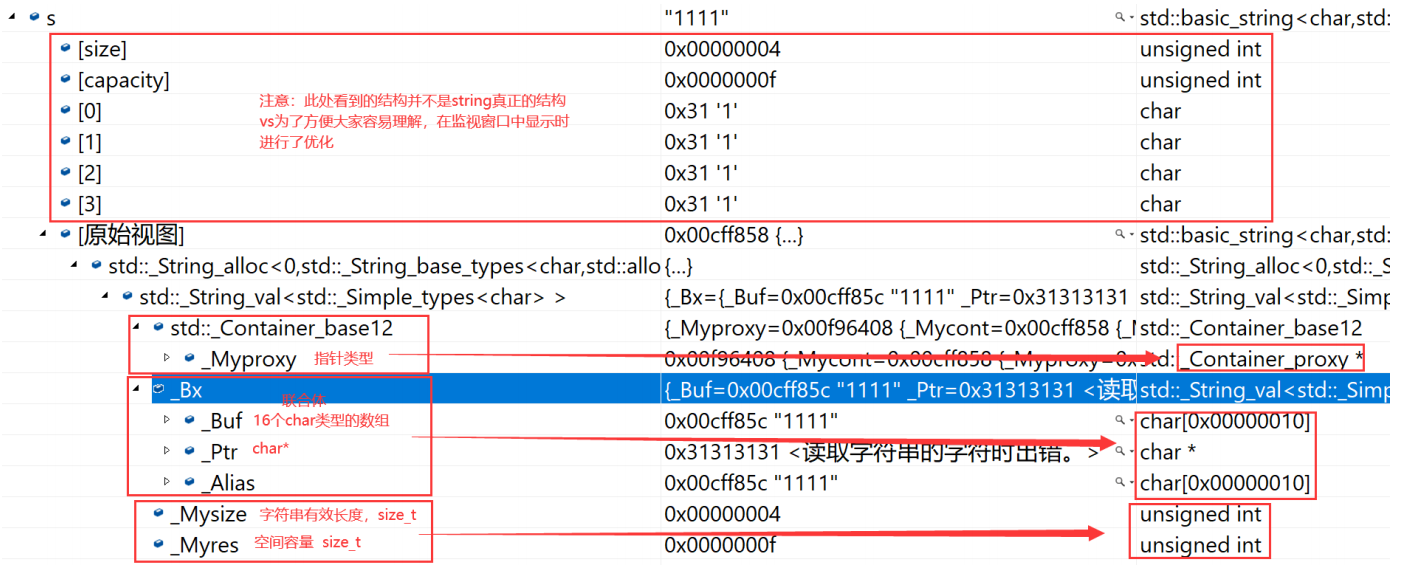
⚪g++下string的结构
G++ 下,string 是通过写时拷贝实现的,string 对象总共占 4 个字节,内部只包含了一个指针,该指针将来指向一块堆空间,内部包含了如下字段:
- 空间总大小
- 字符串有效长度
- 引用计数
struct _Rep_base
{
size_type _M_length;
size_type _M_capacity;
_Atomic_word _M_refcount;
};
- 指向堆空间的指针,用来存储字符串。
二、string类的模拟实现
1、经典的string类问题
模拟实现 string 类,最主要是实现 string 类的构造、拷贝构造、赋值运算符重载以及析构函数。下面这个 string 类的实现是否有问题呢?
// 为了和标准库区分,此处使用String
class String
{
public:
/*
String()
:_str(new char[1])
{*_str = '\0';}
*/
//String(const char* str = "\0") 错误示范
//String(const char* str = nullptr) 错误示范
String(const char* str = "")
{
// 构造String类对象时,如果传递nullptr指针,可以认为程序非法
if (nullptr == str)
{
assert(false);
return;
}
_str = new char[strlen(str) + 1];
strcpy(_str, str);
}
~String()
{
if (_str)
{
delete[] _str;
_str = nullptr;
}
}
private:
char* _str;
};
void TestString()
{
String s1("hello world!");
String s2(s1);
}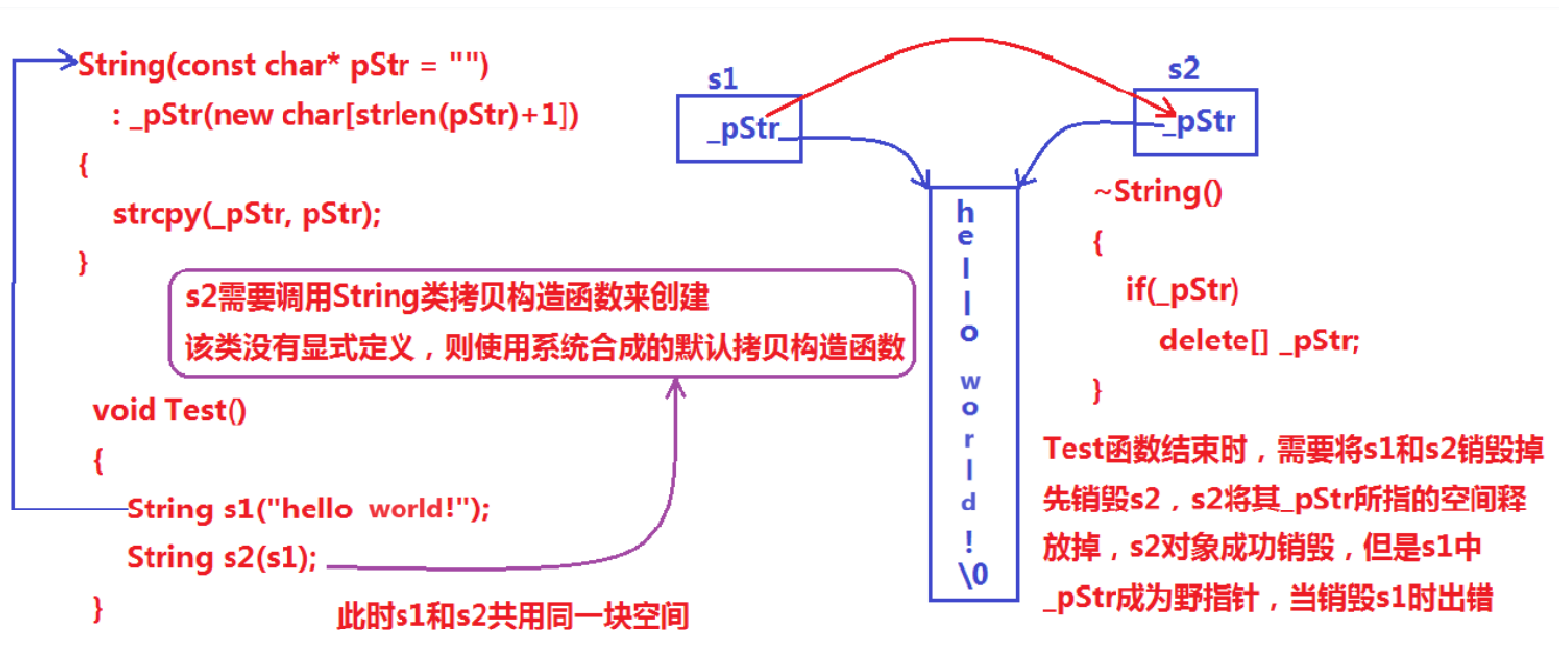
说明 :上述 String 类没有显式定义其拷贝构造函数与赋值运算符重载,此时编译器会合成默认的,当用 s1 构造 s2 时,编译器会调用默认的拷贝构造。最终导致的问题是,s1、s2 共用同一块内存空间,在释放时同一块空间被释放多次而引起程序崩溃,这种拷贝方式,称为浅拷贝。
2、浅拷贝
浅拷贝 :也称位拷贝,编译器只是将对象中的值拷贝过来。如果对象中管理资源,最后就会导致多个对象共 享同一份资源,当一个对象销毁时就会将该资源释放掉,而此时另一些对象不知道该资源已经被释放,以为 还有效,所以当继续对资源进项操作时,就会发生发生了访问违规。
可以 采用深拷贝解决浅拷贝问题 ,即:每个对象都有一份独立的资源,不要和其他对象共享。
3、深拷贝
如果一个类中涉及到资源的管理,其拷贝构造函数、赋值运算符重载以及析构函数必须要显式给出。一般情况都是按照深拷贝方式提供。
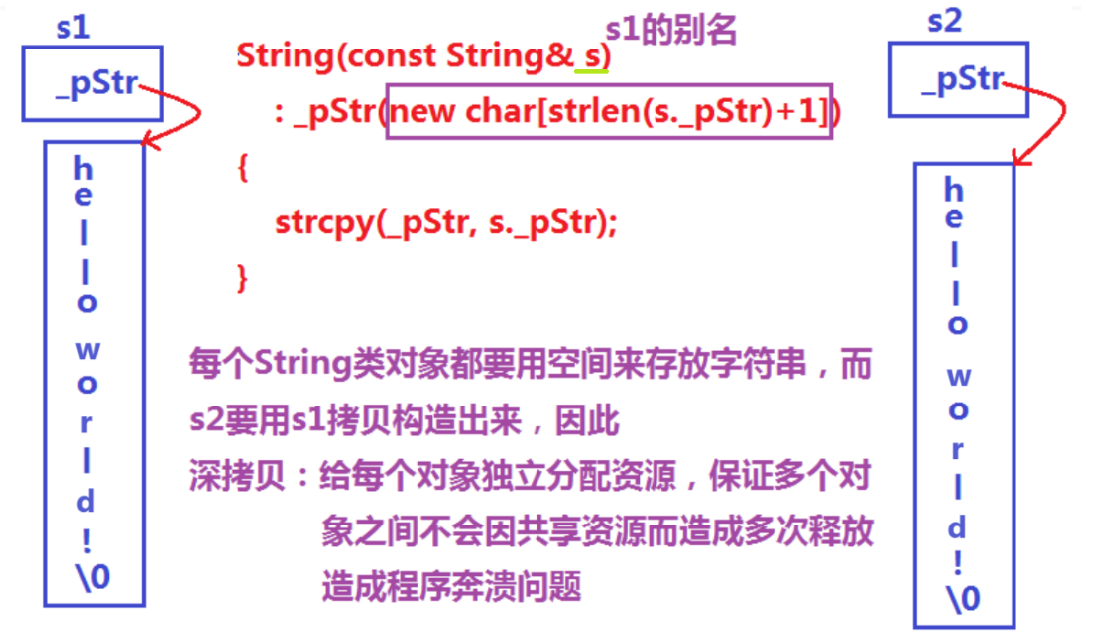
(1)传统版写法的String类
class String
{
public:
String(const char* str = "")
{
// 构造String类对象时,如果传递nullptr指针,可以认为程序非法
if (nullptr == str)
{
assert(false);
return;
}
_str = new char[strlen(str) + 1];
strcpy(_str, str);
}
String(const String& s)
: _str(new char[strlen(s._str) + 1])
{
strcpy(_str, s._str);
}
String& operator=(const String& s)
{
if (this != &s)
{
char* pStr = new char[strlen(s._str) + 1];
strcpy(pStr, s._str);
delete[] _str;
_str = pStr;
}
return *this;
}
~String()
{
if (_str)
{
delete[] _str;
_str = nullptr;
}
}
private:
char* _str;
};(2)现代版写法的String类
class String
{
public:
String(const char* str = "")
{
if (nullptr == str)
{
assert(false);
return;
}
_str = new char[strlen(str) + 1];
strcpy(_str, str);
}
String(const String& s)
: _str(nullptr)
{
String strTmp(s._str);
swap(_str, strTmp._str);
}
// 下面两个的赋值实现,前者更好
String& operator=(String s)
{
swap(_str, s._str);
return *this;
}
//下面的实现方式缺点:需要进行额外的判断和创建临时对象,增加了代码的复杂度和开销
//String& operator=(const String& s)
//{
// if(this != &s)
// {
// String strTmp(s);
// swap(_str, strTmp._str);
// }
// return *this;
//}
~String()
{
if (_str)
{
delete[] _str;
_str = nullptr;
}
}
private:
char* _str;
};(3)写时拷贝
引用计数:用来记录资源使用者的个数。在构造时,将资源的计数给成 1,每增加一个对象使用该资源,就给计数增加 1,当某个对象被销毁时,先给该计数减 1,然后再检查是否需要释放资源,如果计数为 1,说明该对象时资源的最后一个使用者,将该资源释放;否则就不能释放,因为还有其他对象在使用该资源。
(4)string类的模拟实现
#pragma once
#include <iostream>
using namespace std;
#include <assert.h>
namespace xyl
{
class string
{
public:
typedef char* iterator;
public:
string(const char* str = "")
{
_size = strlen(str);
_capacity = _size;
_str = new char[_capacity + 1];
// +1确保有足够的空间存储字符串,因为还需要额外的一个字节来存储'\0'
strcpy(_str, str);
}
string(const string& s)
: _str(nullptr)
, _size(0)
, _capacity(0)
{
string tmp(s._str);
this->swap(tmp);
}
string& operator=(string s)
{
this->swap(s);
return *this;
}
~string()
{
if (_str)
{
delete[] _str;
_str = nullptr;
}
}
// iterator
iterator begin()
{
return _str;
}
iterator end()
{
return _str + _size;
}
// modify
void push_back(char c)
{
if (_size == _capacity)
{
reserve(_capacity * 2);
}
_str[_size++] = c;
_str[_size] = '\0';
}
string& operator+=(char c) //用于将一个字符追加到字符串的末尾
{
push_back(c);
return *this;
}
void append(const char* str);
string& operator+=(const char* str);
void clear()
{
_size = 0;
_str[_size] = '\0';
}
void swap(string& s)
{
std::swap(_str, s._str);
std::swap(_size, s._size);
std::swap(_capacity, s._capacity);
}
const char* c_str()const // 返回一个指向字符串的常量字符指针
{
return _str;
}
// capacity
size_t size()const
{
return _size;
}
size_t capacity()const
{
return _capacity;
}
bool empty()const
{
return 0 == _size;
}
void resize(size_t newSize, char c = '\0')
{
if (newSize > _size)
{
// 如果newSize大于底层空间大小,则需要重新开辟空间
if (newSize > _capacity)
{
reserve(newSize);
}
memset(_str + _size, c, newSize - _size);
}
_size = newSize;
_str[newSize] = '\0';
}
void reserve(size_t newCapacity)
{
// 如果新容量大于旧容量,则开辟空间
if (newCapacity > _capacity)
{
char* str = new char[newCapacity + 1];
strcpy(str, _str);
// 释放原来旧空间,然后使用新空间
delete[] _str;
_str = str;
_capacity = newCapacity;
}
}
// access
char& operator[](size_t index) // 用于访问字符串中指定位置的字符
{
assert(index < _size);
return _str[index];
}
const char& operator[](size_t index)const
{
assert(index < _size);
return _str[index];
}
bool operator<(const string& s);
bool operator<=(const string& s);
bool operator>(const string& s);
bool operator>=(const string& s);
bool operator==(const string& s);
bool operator!=(const string& s);
// 返回c在string中第一次出现的位置
size_t find(char c, size_t pos = 0) const;
// 返回子串s在string中第一次出现的位置
size_t find(const char* s, size_t pos = 0) const;
// 在pos位置上插入字符c,并返回该字符的位置
string& insert(size_t pos, char c);
// 在pos位置上插入字符串str,并返回该字符的位置
string& insert(size_t pos, const char* str);
// 删除pos位置上的元素,并返回该元素的下一个位置
string& erase(size_t pos, size_t len);
private:
friend ostream& operator<<(ostream& _cout, const xyl::string& s);
friend istream& operator>>(istream& _cin, xyl::string& s);
private:
char* _str;
size_t _capacity;
size_t _size;
};
ostream& operator<<(ostream& _cout, const xyl::string& s)
{
// 不能使用cout, 因为string的字符串内部可能会包含\0
// 直接cout时, 是将_str当成char*打印的,遇到内部的\0时后序内容就不打印了
//cout << s._str;
for (size_t i = 0; i < s.size(); ++i)
{
_cout << s[i];
}
return _cout;
}
}
// 对自定义的string类进行测试
void Teststring()
{
xyl::string s1("hello");
s1.push_back(' ');
s1.push_back('w');
s1.push_back('o');
s1.push_back('r');
s1 += 'l';
s1 += 'd';
cout << s1 << endl; //hello world
cout << s1.size() << endl; //11
cout << s1.capacity() << endl; //20
// 利用迭代器打印string中的元素
xyl::string::iterator it = s1.begin();
while (it != s1.end())
{
cout << *it;
++it;
}
cout << endl;
// 这里可以看到一个类只要支持的基本的iterator,就支持范围for
for (auto ch : s1)
{
cout << ch;
}
cout << endl;
}